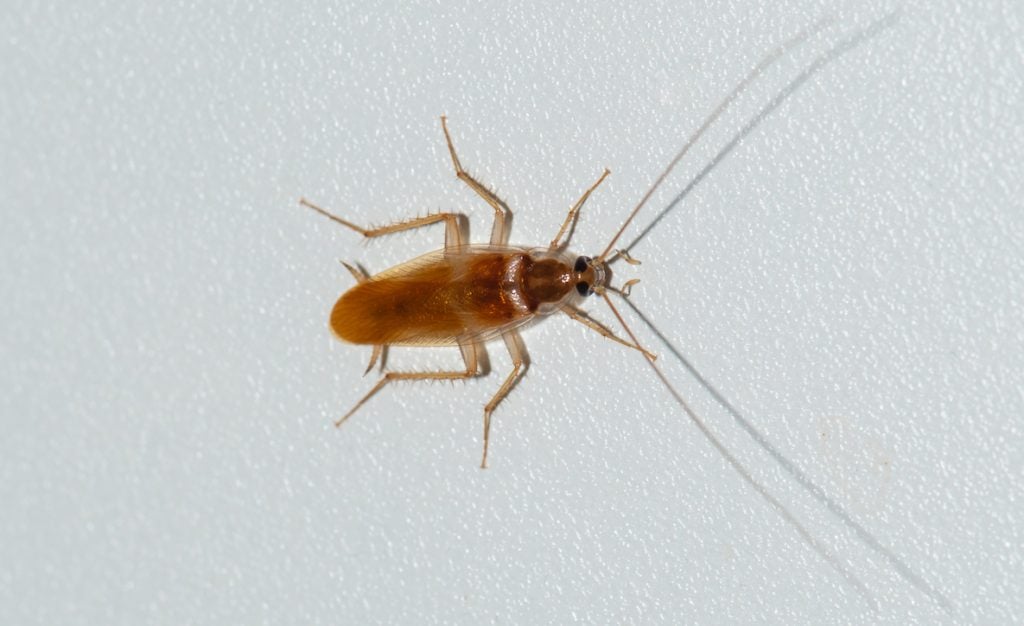Brown banded cockroach (Supella longipalpa)

Other common names:
The brown banded cockroach is sometimes call the furniture cockroach, due to its habit to infest throughout residences and not just kitchens and bathrooms as tends to be the case with the German cockroach.
Invasive / native:
Invasive
Distribution:
Not as common or as widely distributed as the German cockroach but found in many countries, generally preferred warmer temperatures and surviving dryer conditions than German cockroaches.
Typical harbourage locations:
Brown banded cockroaches are only found around humans and in areas of human activity – they are truly domestic cockroaches. They are capable of surviving dryer conditions than German cockroaches, and so will commonly be found away from kitchens and bathrooms, in living areas and bedrooms. They are more commonly found in offices, hospitals, schools and industrial facilities, than in food preparation facilities.
They typically harbourage in cracks and crevices behind or within electrical appliances, in furniture and behind pictures and cupboards. The brown banded cockroach appears to prefer higher harbourage positions with the vast majority of ootheca found on the upper third of walls.
Population structure:
Brown banded cockroaches live in aggregations – cockroaches of all ages (young nymphs to adults). Whereas the cockroaches don’t activity co-operate as a community, the young cockroach nymphs, which tend not to leave the harbourage, benefit from this arrangement as they feed on the droppings and vomit of older cockroaches. Due to their small size, they are able to live in large numbers in the smallest of spaces.
Brown banded cockroach identification:
Adults:
Colour: Light brown colour with two diffuse dark bands seen on the closed wings. Tan to dark brown, with two dark stripes running the length of the pronotum (shield behind the head). They lack the two dark vertical stripes visible on the pronotum of German cockroaches.
Size: Up to 15 mm
Males: Thin and slender, with wings longer than their body. Able to fly.
Females: Short and stout, with short non-functional wings.
Egg cases:
Egg cases are small (approx. 5mm) and a yellow / reddish brown colour.
Nymphs:
Colour: Dark brown head and edges to the abdomen, light brown elsewhere, with two obvious horizontal bands across the thorax.
Size: From 3 mm
Brown banded cockroach life-cycle
Eggs: Up to 18 eggs per ootheca (egg case). Ootheca deposited several weeks before hatching, glued in a dark, potential harbourage.
Number of nymphal stages/moults to adult: 6-8
Length of life-cycle (Egg to adult): 100 days
Life span of adult: 6 months+
Food preferences:
Cockroaches will eat everything! But brown banded cockroaches have a preference for items containing starch, so books and wallpaper are on the menu. They will also eat fabrics – curtains and upholstery.
Distinguishing features / behaviours:
- The brown banded cockroach have obvious palps visible at the front of their head (thus their name – longipalpa)
- The brown banded cockroach has the fastest reproductive rate of all the pest cockroaches. A female can produce a new ootheca every few weeks and up to 14 over her lifetime
- When disturbed the males will fly away, whilst the females run
- The brown banded cockroach can be confused with the Asian and German cockroaches. The light horizontal bands on the nymphs and the dark horizontal bands on the adults are the key identifiers
Diseases:
Although like other cockroaches, brown banded cockroaches have the potential to transfer disease, since they are not generally closely associated with sewers and drains, this is not the major concern with brown banded cockroaches. However, they spent skins and droppings are a source of allergens and with their preferred harbourage locations being living areas and bedrooms in domestic residences, they are seen as a potential cause of allergic reactions and asthma problems.
Prevention tips:
Although good hygiene is generally the best approach to prevent a cockroach problem, due to the fact brown banded cockroaches will happily feed on non-food items away from the kitchen, this doesn’t necessarily prevent a brown banded cockroach problem rearing its head.
Probably the best tip is to inspect any cardboard boxes or good being brought into the property for ootheca (egg cases). Also, regularly check and vacuum behind picture frames and cupboards / furniture.
General good hygiene tips to preventing a cockroach infestation:
- Keep food preparation areas clean – clean up food spills and clear away dishes after meals
- Make sure the dishwasher is run regularly
- Regularly clean cooker, grill, extraction fan, dishwasher and refrigerator (especially underneath)
- Don’t leave unfinished pet food out overnight
- Fix any leaks and areas of moisture
- Ensure rubbish is put into sealed containers
Other types of cockroach.
Treatment notes:
Professional Pest Managers can login for more information

